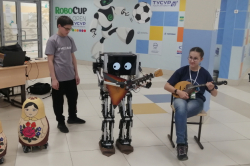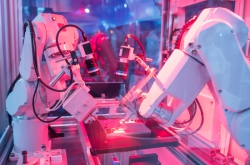Panasonic’s robot fridge
The minibar-sized robot fridge reacts to voice commands and can move around the apartment; depth and laser sensors help it navigate to the place it has to get to. It also uses a special database that allows it to recommend snacks to the beverages it stores. There's still no information on whether the novelty will be mass-produced or not.
 Panasonic’s robot fridge. Credit: beat102103.com
Panasonic’s robot fridge. Credit: beat102103.com
Huawei Mate 9 smartphone with Amazon Alexa voice assistant
Amazon’s Alexa voice assistant has become the leader of CES 2017 (consumer electronics and consumer technology tradeshow held annually in the USA); this makes a strong point in favor of voice control technologies being the future. Most devices we mention in this review make use of the Alexa technology; yet, it was in a smartphone that it's been used for the first time, namely the US release of Huawei Mate 9.
Cars
Alexa has been introduced in cars, as well. As of now, two manufacturers offer the support of this technology. In Ford's cars, the voice assistant can be used to start the car, block doors and check the fuel margin, as well as for remote control of smart home appliances. Volkswagen also supports Alexa, as well as INRIX OpenCar software suite.
Samsung Powerbot VR7000
 Powerbot VR7000. Credit: hitechcentury.com
Powerbot VR7000. Credit: hitechcentury.com
The new innovative robotic vacuum cleaner from Samsung, Powerbot VR7000 is fitted with several intelligent functions, including Visual Mapping Plus and FullView Sensor 2.0 that allow it to build a virtual map of the room and remember it so as to clean better; also, it uses the Intelligent Power Control function to adjust the suction power according to the type of the floor's surface. Yet, its most interesting feature is that it can be connected to the IoT infrastructure, and be controlled via a special smartphone app or voice commands using the Amazon Echo device.
LG Hub Robot
LG Hub Robot supports Alexa voice control technology and can be used to convey commands to other Smart House systems. For instance, you can tell it to turn the conditioning on or launch a tumble dry cycle. The robot is fixed with an interactive display that can show all kinds of information, from the contents of the fridge to different recipes. What's more, it possesses several other useful functions - it can take notes, make reminders, convey the traffic situation and the weather forecast, play music and the like.
 LG Hub Robot. Credit: cnet.com
LG Hub Robot. Credit: cnet.com
LG Hub Robot is intended for family use, so in order to become a real family member, it has been given the ability to change facial expressions and react to the users with body language (nod his head when answering simple questions, for instance). It can even discern family members from each other using a camera and can be programmed to greet each of them differently.
Lynx by UBTech Robotics
This humanoid robot is similar to the previous one, and also uses the Alexa Amazon technology; same as LG Hub Robot, it can play music and activate appliances when told so. Yet, Lynx uses Alexa in combination with its own Ubtech speech recognition system, knowledge of the natural language and search functions so as to create the "lifelike human-to-robot interface".
Lynx's goal is to interact with family members. The robot can greet them or play different music depending on a particular person's taste; it can synchronize with calendars or help make purchases via the Internet - all one has to do is just tell it to.
Cruzr by Ubtech

Cruzr by Ubtech. Credit: YouTube.com
This is a robot made for hugging! Cruzr is an android that can be used in shops, hotels, airports and other places for interacting with clients; the robot can be adjusted in such a way as to better suit a particular business field. Cruzr has flexible hands that allow it to dance, shake hands and even hug people; it recognizes voice commands and has a mapping technology, as well as instruments for organizing video conferences. The self-recharge function guarantees that the robot will return to the charging station when its battery is almost depleted.





